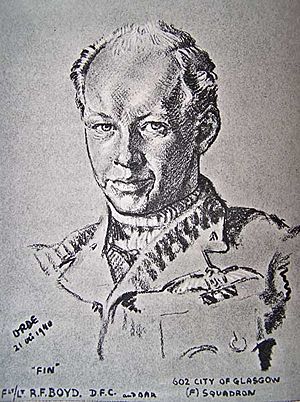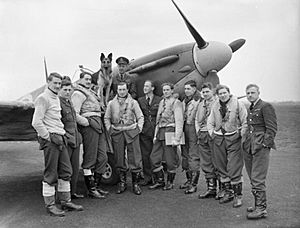Robert Boyd (RAF officer) facts for kids
Quick facts for kids
Robert Boyd
|
|
|---|---|

Portrait of Boyd, made by Cuthbert Orde in October 1940
|
|
| Born | 8 June 1916 East Kilbride, Scotland |
| Died | 22 February 1975 (aged 58) Renfrew, Scotland |
| Allegiance | United Kingdom |
| Service/ |
Royal Air Force |
| Years of service | 1935–1945 |
| Rank | Group Captain |
| Commands held | No. 293 Wing Kenley Wing No. 54 Squadron |
| Battles/wars | Second World War |
| Awards | Distinguished Service Order Distinguished Flying Cross & Bar Mention in Despatches |
Robert Findlay Boyd (born June 8, 1916 – died February 22, 1975) was a brave British pilot. He served in the Royal Air Force (RAF) during the Second World War. He was known as a "flying ace" because he shot down at least 14 enemy aircraft.
Robert Boyd was born in East Kilbride, Scotland. He joined the Royal Auxiliary Air Force in 1935. When World War II started, he joined the main RAF. He became famous for his aerial victories during the Battle of Britain. For his bravery, he received the Distinguished Flying Cross and a special Bar (meaning he got the award a second time).
Later in 1940, he became the leader of No. 54 Squadron. He led them during the early parts of the Circus offensive in 1941. He shot down more planes from the German air force, called the Luftwaffe. He was then awarded the Distinguished Service Order. From December 1941 to April 1942, he was a wing leader at RAF Kenley. Later in the war, he served in South Asia. By the end of the war, he was a Group Captain, a high rank. After the war, he returned to civilian life and lived on the Isle of Skye.
Contents
Robert Boyd's Early Life
Robert Findlay Boyd was born on June 8, 1916, in East Kilbride, Scotland. In 1935, he joined No. 602 Squadron. This was part of the Royal Auxiliary Air Force, a volunteer air force. He became a pilot officer that same year. Two years later, he was promoted to flying officer.
When World War II began, Robert was working as a mining engineer. He was called up to serve in the Royal Air Force (RAF). He quickly became a flight lieutenant.
Robert Boyd in World War II
In September 1939, when the war started, No. 602 Squadron flew Supermarine Spitfire fighter planes. They were first based at Abbotsinch. In October, they moved to Grangemouth. From there, they flew patrols over the Firth of Forth. On October 16, they helped stop Luftwaffe attacks on the United Kingdom. They achieved the first aerial victories for British planes since World War I. On July 7, 1940, Robert and two other pilots helped destroy a Junkers Ju 88 medium bomber. They found it east of St Abb's Head.
Battle of Britain Hero
As the Battle of Britain became more intense, No. 602 Squadron moved to Westhampnett in southern England. They were part of the Tangmere Wing. The squadron often flew to stop German bombers before they reached the English coast. Later, when the Luftwaffe attacked London, the squadron fought more over England itself.
Robert Boyd was now a flight commander. On August 15, 1940, he helped shoot down a Dornier Do 17 medium bomber. It was south of Portland. The next day, he destroyed a Junkers Ju 87 dive bomber south of his airfield at Westhampnett. He had just taken off, and the Ju 87 was an easy target. Later that day, he helped shoot down a Heinkel He 111 medium bomber north of Worthing.
August 18 was known as The Hardest Day of the Battle of Britain. On this day, Robert destroyed a Ju 87 and a Messerschmitt Bf 109 fighter. He also damaged another Ju 87, all near the airfield at Ford. The next day, he and other pilots stopped a Ju 88 over Tangmere and destroyed it.
On August 25, Robert shot down two Bf 109s near Dorchester. On September 4, he destroyed a Do 17 near Arundel. He also shot down a Bf 109 in the same area that day. On September 11, south of Selsey Bill, he destroyed one Bf 109 and damaged another. On September 21, he was one of several pilots who worked together to destroy a Ju 88 south of Brighton.
On September 26, he shot down one Bf 109 and likely destroyed a second, both near Southampton. By this time, he had received the Distinguished Flying Cross (DFC). The award recognized his leadership and skill.
In early October, Robert and his wingman destroyed a Ju 88 off Selsey Bill. Later that month, he received a Bar to his DFC. This meant he had earned the award a second time. The award noted he had destroyed at least 12 enemy aircraft. It also praised his leadership.
On November 13, Robert again helped other pilots destroy a Ju 88 north of Brighton. In early December, he was promoted to temporary squadron leader. He became the commander of No. 54 Squadron. His new squadron had fought hard in southern England. They moved to Catterick for a rest. They only flew a few times for the next few months. In February 1941, the squadron moved south to Hornchurch.
Circus Offensive Missions
The RAF started the Circus offensive in early 1941. This involved flying missions over France to draw out the Luftwaffe. No. 54 Squadron took part in these operations. On April 17, Robert shot down a Messerschmitt Bf 110 heavy fighter into the English Channel. It was east of Manston. On June 22, he was protecting Bristol Blenheim light bombers attacking railways at Hazebrouck. He likely destroyed a Bf 109. Four days later, he shot down another Bf 109 northeast of Gravelines.
On July 8, he was escorting Short Stirling heavy bombers to Lille. He destroyed one Bf 109 and damaged another. Two days later, near Gravelines again, he shot down a Bf 109. A week after that, he destroyed a Bf 109 over Hardelot.
Later in July, Robert stopped flying combat missions. He became an instructor at No. 58 Operational Training Unit at Grangemouth. In November, he returned to combat. He became the wing leader of the Kenley Wing. This wing was based at Kenley and included three squadrons: No. 452 Squadron, No. 485 Squadron, and his old unit, No. 602 Squadron.
On February 12, 1942, Robert was flying with Group Captain Victor Beamish. They were over the English Channel. They saw the German battleships Scharnhorst and Gneisenau, and the cruiser Prinz Eugen. These ships were making their 'Channel Dash' past England. Robert and Beamish kept radio silence as ordered. They raised the alarm when they returned to Hornchurch.
On February 19, he damaged a Bf 109 near Beachy Head. In early March, he was promoted to temporary wing commander. On March 28, he claimed a Focke Wulf 190 fighter as likely destroyed near Cap Gris-Nez. He damaged two Fw 190s near Gravelines on April 12. He received the Distinguished Service Order (DSO) that same month. The award recognized his leadership and skill. It noted he had destroyed 12 more enemy aircraft since his last award.
Later War Service
After receiving the DSO, Robert Boyd left command of Kenley Wing. He became the station commander at Eglinton. On March 15, 1943, he achieved his last aerial victory. He damaged a Ju 88 northwest of Donegal.
He was then sent to India. He served at the headquarters of the Third Tactical Air Force in Bengal. From April 1944, he led No. 293 Wing. His rank of wing commander became permanent later that year.
By early January 1945, Robert Boyd was a group captain. He had also been mentioned in despatches, which is another recognition for bravery. He left the RAF after the war ended. He was credited with destroying 14 German aircraft. He also shared in destroying seven others. He likely destroyed three more planes and damaged seven.
Robert Boyd's Later Life
After the war, Robert Boyd worked as a pilot for Scottish Aviation. Later, he became a farmer and a commercial fisherman. In his final years, he lived on the Isle of Skye. He also ran a pub in Uig. He passed away on February 22, 1975. He was visiting a friend, George Pinkerton, in Renfrew, Scotland, when he died.


